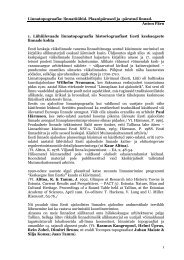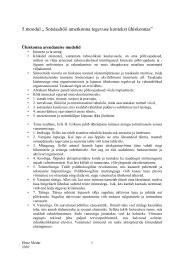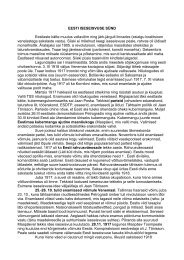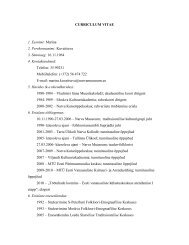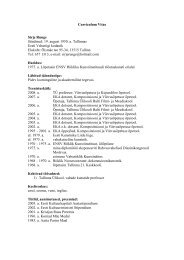crowding and children's mental health: the role of house type
crowding and children's mental health: the role of house type
crowding and children's mental health: the role of house type
Create successful ePaper yourself
Turn your PDF publications into a flip-book with our unique Google optimized e-Paper software.
230 G. W. Evans et al.<br />
crowded homes. Develop<strong>mental</strong> Psychology, 35, 1020^<br />
1023.<br />
Evans, G. W., Palsane, M. N., Lepore, S. J. & Martin, J.<br />
(1989). Residentialdensity <strong>and</strong> psychological<strong>health</strong>:<br />
<strong>the</strong> mediating e¡ects <strong>of</strong> socialsupport. Journal<strong>of</strong>Personality<br />
<strong>and</strong> Social Psychology, 57, 994^999.<br />
Evans, G. W., Wells, N. & Moch, A. (in press). Housing <strong>and</strong><br />
<strong>mental</strong><strong>health</strong>: a review <strong>of</strong> <strong>the</strong> evidence <strong>and</strong> a methodological<br />
<strong>and</strong> conceptual critique. Journal <strong>of</strong> Social<br />
Issues<br />
Fisher, L. D. & van Belle, G. (1993). Biostatistics. NewYork:<br />
Wiley.<br />
Gabe, J. & Williams, P. (1987). Women, housing <strong>and</strong> <strong>mental</strong><br />
<strong>health</strong>. International Journal <strong>of</strong> Health Sciences, 17,<br />
667^679.<br />
Ghiselli, E., Campbell, J. & Zedeck, S. (1981). Measurement<br />
Theory for <strong>the</strong> Behavioral Sciences. San Francisco:<br />
Freeman.<br />
Gi¡ord, R. (in press). Satisfaction, <strong>health</strong>, security, <strong>and</strong><br />
socialrelations in high-rise buildings. In A. Seidel&<br />
T. Heath (Eds), Social E¡ects <strong>of</strong> <strong>the</strong> Building Environment.<br />
London: E & FN Spon.<br />
Gillis, A. (1974). Population density <strong>and</strong> social pathology:<br />
<strong>the</strong> case <strong>of</strong> building <strong>type</strong>, social allowance, <strong>and</strong><br />
juvenile delinquency. Disease <strong>and</strong> Pathology, 53,<br />
306^314.<br />
Gove, W. R. & Hughes, M. (1983). Over<strong>crowding</strong> in <strong>the</strong><br />
Household. New York: Academic.<br />
Halpern, D. (1995). Mental Health <strong>and</strong> <strong>the</strong> Built Environment.<br />
London: Taylor & Francis.<br />
Hassen, R. (1977). Social<strong>and</strong> psychologicalimplications <strong>of</strong><br />
high population density. Civilisations, 27, 230^236.<br />
Hillier, W. & Hanson, J. (1984). Social Logic <strong>of</strong> Space. New<br />
York: Cambridge.<br />
Ineichen,B.(1993).Homes <strong>and</strong> Health. London: E & FN<br />
Spon.<br />
Ineichen, G. & Hooper, D. (1974). Wives’ <strong>mental</strong><strong>health</strong> <strong>and</strong><br />
children’s behavior problem in contrasting residential<br />
areas. Social Science <strong>and</strong> Medicine, 8, 369^374.<br />
Jain, U. (1987). The Psychological Consequences <strong>of</strong> Crowding.<br />
New Delhi: Sage.<br />
Lepore, S. J., Evans, G. W. & Schneider, M. (1991). The<br />
dynamic <strong>role</strong> <strong>of</strong> social support in <strong>the</strong> link between<br />
chronic stress <strong>and</strong> psychological distress.<br />
Journal <strong>of</strong> Personality <strong>and</strong> Social Psychology, 61,<br />
899^909.<br />
Lercher, P. & Schmitzberger, R. (1997). Birth weight, education,<br />
environment, <strong>and</strong> lung function at school age:<br />
a community study in an alpine area. European Respiratory<br />
Journal, 10, 2502^2507.<br />
Marsella, A. J., Escudero, M. & Gordon, P. (1970). The effects<br />
<strong>of</strong> dwelling density on <strong>mental</strong> disorders in Fillipino<br />
men. Journal <strong>of</strong> Health <strong>and</strong> Social Behavior, 11,<br />
288^294.<br />
Mc Carthy, D. & Saegert, S. (1979). Residentialdensity, socialoverload,<br />
<strong>and</strong> socialwithdrawal. In J. R. Aiello &<br />
A. Baum (Eds), Residential Crowding <strong>and</strong> Design. New<br />
York: Plenum, pp. 55^76.<br />
Needleman, H. L. (1983). Low level lead exposure <strong>and</strong> neuropsychological<br />
performance. In M. Rutter & R. R.<br />
Jones (Eds), Lead versus Health Chichester: Wiley, pp.<br />
229^248.<br />
Needleman, H. L., Gunnoe, C., Leviton, A., Reed, R.,<br />
Peresie, H., Maher, C. & Barrett, P. (1979). De¢cits in<br />
psychological <strong>and</strong> classroom performance <strong>of</strong> children<br />
with elevated dentine lead levels. New Engl<strong>and</strong> Journal<br />
<strong>of</strong> Medicine, 300, 689^695.<br />
Needleman, H. L., Schell, A., Bellinger, D., Leviton, A. &<br />
Allard, E. (1990). The long term e¡ects <strong>of</strong> exposure to<br />
low doses <strong>of</strong> lead in childhood: an eleven year follow<br />
up report. New Engl<strong>and</strong> Journal <strong>of</strong> Medicine, 322,<br />
83^88.<br />
Ravens-Sieberer, U. & Bullinger, M. (1998). Assessing<br />
<strong>health</strong> related quality <strong>of</strong> life in children with <strong>the</strong><br />
German KINDL. Quality <strong>of</strong> Life Research, 7, 399^407.<br />
Richman, N. (1977). Behavior problems in preschool children:<br />
family <strong>and</strong> social factors. British Journal <strong>of</strong><br />
Psychiatry, 131, 523^527.<br />
Saegert, S. (1982). Environment <strong>and</strong> children’s <strong>mental</strong><br />
<strong>health</strong>: residential density <strong>and</strong> low income children.<br />
In A. Baum & J. E. Singer (Eds), H<strong>and</strong>book <strong>of</strong> Psychology<br />
<strong>and</strong> Health. Hillsdale, NJ: Erlbaum, pp. 247^271.<br />
Schae¡er, M., Baum, A., Paulus, P. B. & Gaes, G. (1988).<br />
Architecturally mediated e¡ects <strong>of</strong> social density in<br />
prison. Environment <strong>and</strong> Behavior, 20, 3^19.<br />
Wachs, T. D. (1989). The nature <strong>of</strong> <strong>the</strong> physicalmicroenvironment:<br />
an exp<strong>and</strong>ed classi¢cation system. Merrill<br />
Palmer Quarterly, 35, 399^ 419.<br />
Wachs, T. D. & Gruen, G. (1982). Early Experience <strong>and</strong> Human<br />
Development. New York: Plenum.<br />
Winneke, G., Brockhaus, A., Ewers, U., Kramer, U. &<br />
Neuf, M. (1990). Results from <strong>the</strong> European multicenter<br />
study on lead neurotoxicity in children. Neurotoxicology<br />
<strong>and</strong> Teratology, 12, 553^559.<br />
Wohlwill, J. F. & Heft, H. (1987). The physical environment<br />
<strong>and</strong> <strong>the</strong> development <strong>of</strong> <strong>the</strong> child. In D. Stokols & I.<br />
Altman (Eds), H<strong>and</strong>book <strong>of</strong> Environ<strong>mental</strong> Psychology.<br />
New York: Wiley, pp. 281^328.<br />
Yule, W., Lansdown, R., Miller, I. & Urbanowicz, M. (1981).<br />
The relationship between blood lead level concentrations,<br />
intelligence, <strong>and</strong> attainment in a school population.<br />
Develop<strong>mental</strong> Medicine <strong>and</strong> Child Neurology, 23,<br />
567^576.<br />
Appendix 1<br />
Measures <strong>of</strong> children’s psychological well being<br />
KINDL: Functionalcapacity in everyday life<br />
During <strong>the</strong> last weeky<br />
It was easy for me to do my homework<br />
I had di⁄culty concentrating<br />
I had problems with my teachers<br />
I was nervous <strong>and</strong> ¢dgety<br />
I was proud <strong>of</strong> my achievements<br />
Everything I started worked out<br />
Everything got on my nerves<br />
KINDL: Psychological well being<br />
During <strong>the</strong> last weeky<br />
I felt grumpy <strong>and</strong> moody<br />
I felt ‘stressed out’



![5 Verben 2 S[1]. 35-44.pdf](https://img.yumpu.com/27096544/1/184x260/5-verben-2-s1-35-44pdf.jpg?quality=85)

